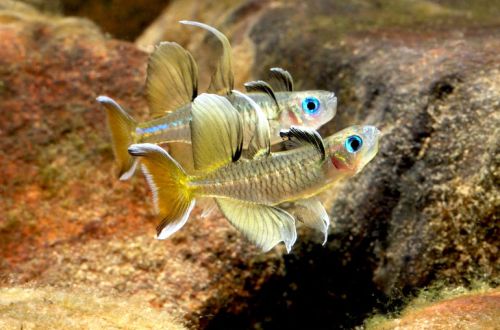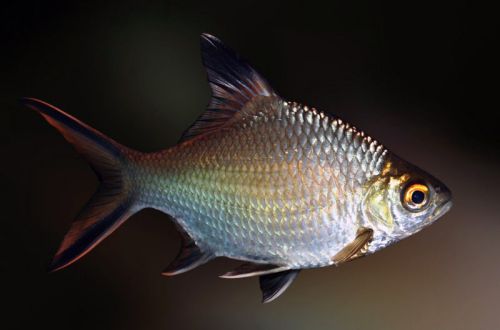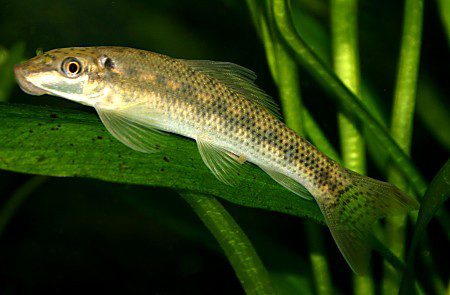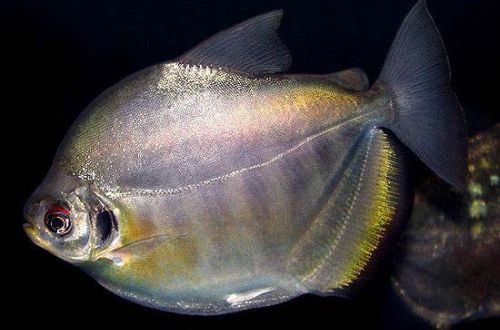
Australian blue-eye
Australian blue-eye or Pseudomugil signifer, scientific name Pseudomugil signifer, belongs to the Pseudomugilidae family. An amazing fish in every way, it is distinguished not only by its original appearance, but also by the ability to adapt to a variety of habitats. Easy to keep, unpretentious, can get along with other peaceful species, all this makes it an excellent candidate for a general aquarium.

Contents
Habitat
Native to the east coast of Australia and near the lying islands. The natural habitat of this species is extremely diverse. Fish are found in swamps, clean fresh lakes and streams, and in brackish waters, mangroves, salt marshes.
Brief information:
- The volume of the aquarium – from 60 liters.
- Temperature – 20-26°C
- Value pH — 6.0–8.0
- Water hardness – soft to hard (5-22 dGH)
- Substrate type – any
- Lighting – moderate
- Salty water — a concentration of up to 15 g of salt per 1 liter of water is permissible
- Water movement is weak
- The size of the fish is up to 7 cm.
- Meals – any
- Temperament – peaceful
- Keeping a flock of at least 8-10 individuals
Description
The length of an adult varies from 3 to 7 cm. Fish sometimes differ significantly from each other depending on the region of origin, for example, in the north of the continent, the Australian Blue-eye is larger and has more elongated fins compared to relatives from the southern regions. The color of the body is yellowish with a silver overflow on the head. A characteristic feature of the species is the blue iris of the eyes, which is reflected in the name of this species.
Food
It feeds near the surface and in the water column, so it is undesirable to use sinking feed. If possible, the diet should be diversified with live foods, for example, small bloodworms, brine shrimp, daphnia.
Maintenance and care, arrangement of the aquarium
The optimal size of the aquarium for a small flock of fish from the southern part of the mainland starts from 60 liters, respectively, for the “northerners” the volume should be larger, since they are larger. A universal design method is the presence of areas with dense vegetation along with open areas for swimming. Adding a few natural or artificial driftwood is welcome. If the Australian blue-eye was not caught from the wild, but grown on a fish farm or in another aquarium, then there will be no problems with its maintenance. It is enough to create similar water conditions with those that were at the place of purchase. The fish are highly adaptable, so in the process of maintaining the aquarium, the habitat conditions can be gradually changed in the direction that suits you in order to reduce maintenance costs. It is permissible to contain in brackish water at a concentration of up to 10-15g. per 1 liter.
Behavior and Compatibility
Most representatives of the species are peaceful and calm fish that are perfectly combined in a common aquarium with neighbors of a similar size and temperament from among the haracin, cyprinids, catfish and others. The content is flocking in the amount of at least 8–10 individuals.
It is worth noting that the males of the northern varieties of Sineglazka are very belligerent towards each other and during the spawning period they are able to arrange fierce fights. Weaker individuals may even die from their injuries.
Breeding / breeding
In nature, the mating season lasts from October to December, but in a home aquarium, under stable conditions, it can begin at any time. Fish attach their eggs to the surface of small-leaved plants or mosses with sticky threads, or artificial vegetation can serve as an alternative. Spawning lasts several days, during which time the female lays several batches of eggs, which can be fertilized by several males. The incubation period lasts from 10 to 21 days depending on the temperature. Parental instincts are not developed, adult fish often eat their own eggs and fry.
In an aquarium with dense vegetation, there is a chance that a small percentage of the total brood will survive. If there is a desire to preserve the offspring, then the eggs can be carefully placed in a separate tank with identical water conditions, in which they will continue to grow fry. Feed specialized powdered food and/or brine shrimp nauplii.
Fish diseases
Health problems arise only in case of injuries or when kept in unsuitable conditions, which depresses the immune system and, as a result, provokes the occurrence of any disease. In the event of the appearance of the first symptoms, first of all, it is necessary to check the water for the excess of certain indicators or the presence of dangerous concentrations of toxic substances (nitrites, nitrates, ammonium, etc.). If deviations are found, bring all values back to normal and only then proceed with treatment. Read more about symptoms and treatments in the Aquarium Fish Diseases section.





